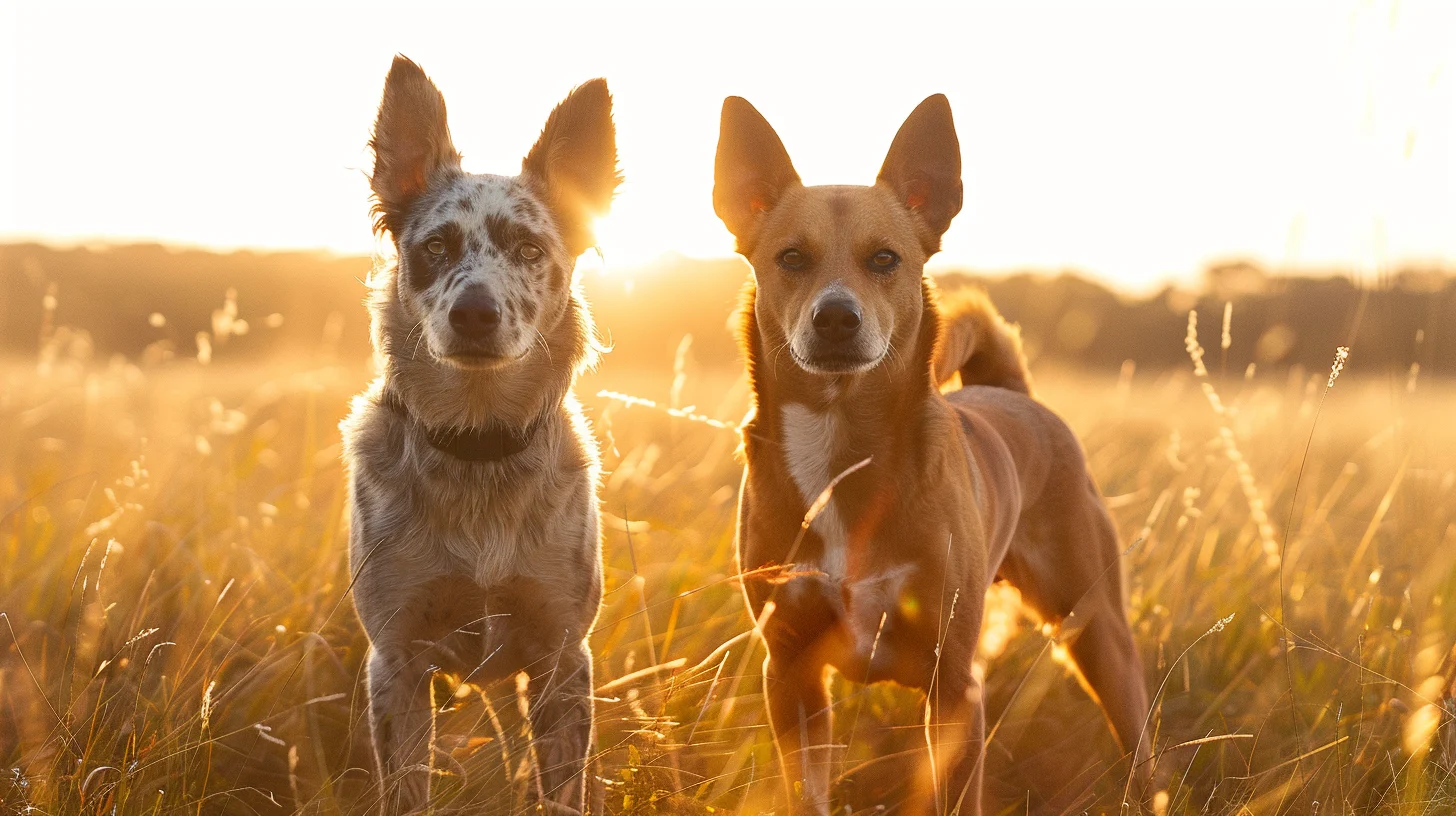When comparing the Queensland Heeler vs Australian Cattle Dog, it’s clear they both come from the same herding background. These dogs were bred to help manage cattle across Australia’s challenging terrain. While they share similarities, their physical traits and temperaments have key differences. Want to know the difference between a Cattle Dog and a Blue Heeler? Check out our Cattle Dog and Blue Heeler comparison article for more information.
The Australian Cattle Dog is slightly larger, standing 18-20 inches tall, while the Queensland Heeler is 17-19 inches. Both breeds weigh between 35 and 50 pounds, making them compact and muscular. No matter which you choose, be prepared for an energetic dog that thrives on exercise.
Quick Navigation
Are Australian Cattle Dogs suitable for first-time dog owners?
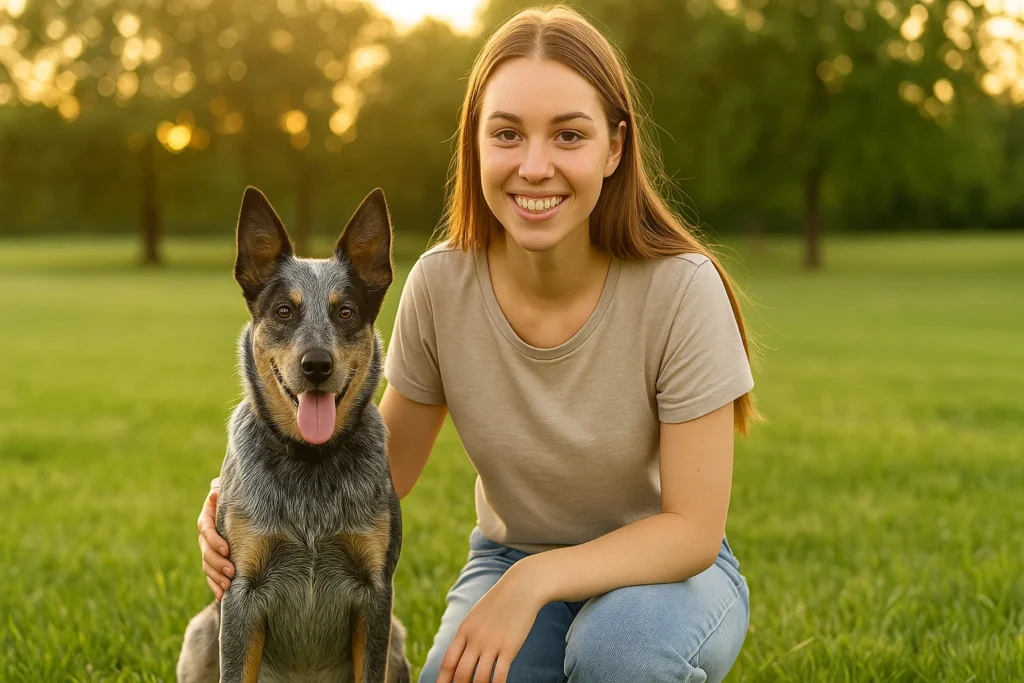
Queensland Heeler vs Australian Cattle Dog can be tricky, especially for first-time dog owners. These high-energy, intelligent, and independent dogs require consistent training, mental stimulation, and plenty of physical activity.
New owners may find active breeds challenging to manage without experience handling them. However, if you’re committed to providing them with the necessary exercise and training, they can be loyal and rewarding companions. It’s essential to have the time and dedication to meet their needs.
Comparison Table
Queensland Heeler vs Australian Cattle Dog Differences
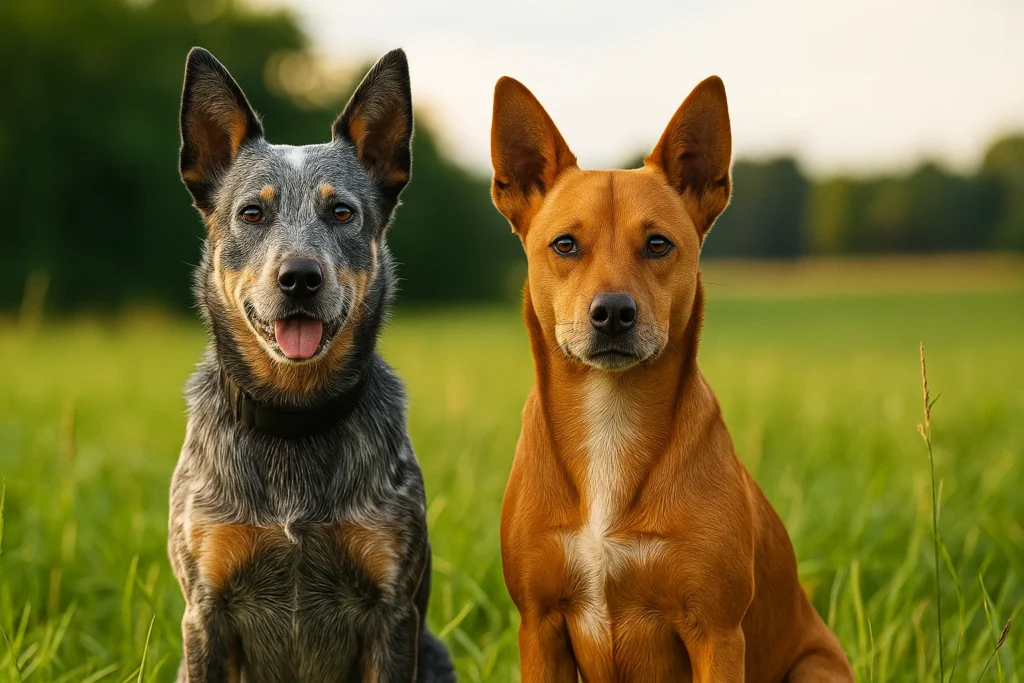
History and Origins
The Australian Cattle Dog and Queensland Heeler share a fascinating history. Both breeds were developed in Australia, primarily focusing on herding cattle over long distances in harsh conditions.
Australian Cattle Dog
The Australian Cattle Dog, often called the “Blue Heeler,” was developed in the mid-1800s. Farmers wanted a reliable herding dog for their cattle, and the breed emerged from crosses between the Blue Merle Collie, Dingo, and other herding dogs.
These dogs were bred for stamina and intelligence, making them capable of working in the Australian outback. They are known for their blue, red, or speckled coats, with the blue variety being most common.
Queensland Heeler
While the Queensland Heeler vs Australian Cattle Dog debate often arises, there’s a slight distinction between the two. The Queensland Heeler, also known as the Australian Stumpy Tail Cattle Dog, shares similar origins but is believed to be one of the oldest and most primitive Australian herding dogs, with roots from the 1800s.
Like the Australian Cattle Dog, it was bred to work on cattle stations but stands apart due to its naturally short tail (or complete lack of one). Its stamina and herding ability were crucial in helping farmers manage cattle over vast Australian landscapes. The article Male vs. Female Dogs highlights the pros and cons of having male or female dogs.
Physical Characteristics
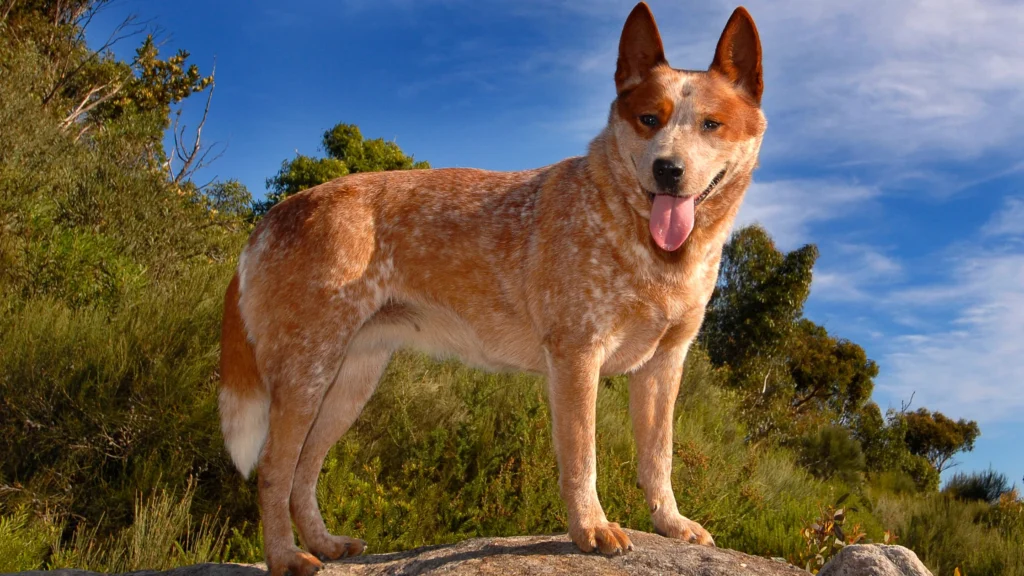
Let’s examine the physical traits of the Queensland Heeler and Australian Cattle Dog. Although these two breeds may look similar, they have some subtle differences in size, coat, and tail.
Size and Build
Queensland Heeler vs Australian Cattle Dog. Both names refer to the same breed, known for its medium size, weighing 15-22 kg (33-48 lbs). They stand around 43-51 cm (17-20 inches) at the shoulder, with a muscular, compact frame that supports their herding abilities.
Coat Type and Colours
Both breeds have short, dense double coats designed for the harsh Australian climate. Queensland Heelers often come in blue or red, with a speckled or mottled pattern. Australian Cattle Dogs share similar colours, but their coats are often a solid blue or red with a few distinct markings.
Tail
One of the more noticeable differences is the tail. The Queensland Heeler is often born with a naturally short or bobbed tail, around 10-20 cm (4-8 inches) in length. Meanwhile, the Australian Cattle Dog has a longer, bushier tail, which can add to its overall height and appearance.
Temperament and Behaviour
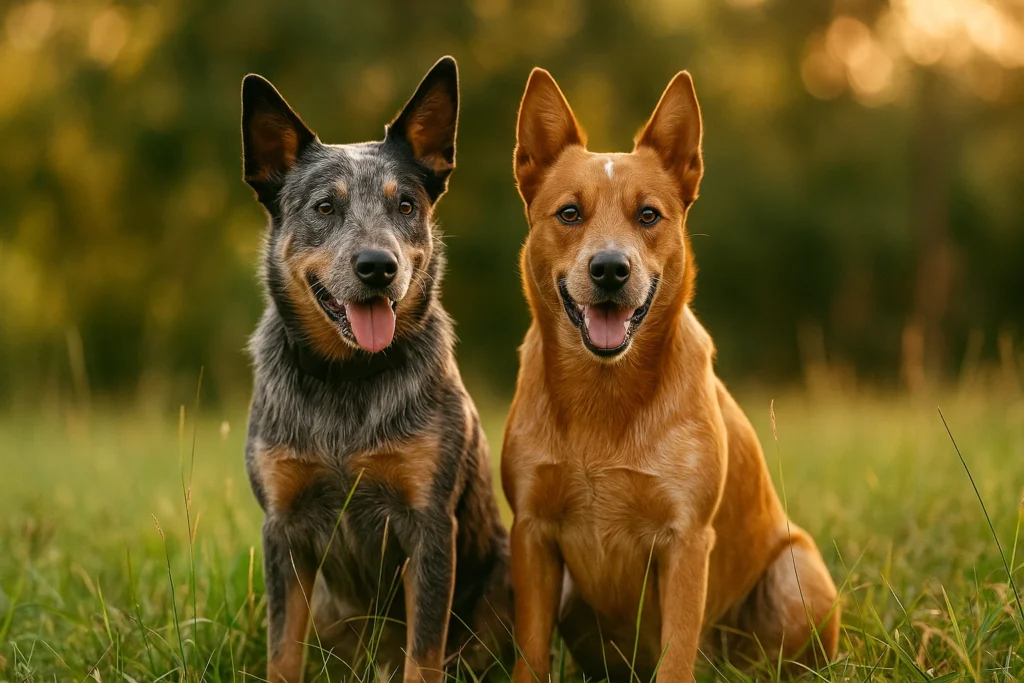
Both the Queensland Heeler and the Australian Cattle Dog have unique temperaments. Understanding their behaviour is key to building a strong bond with these dogs, whether as an owner or a potential owner.
Intelligence and Trainability
Both breeds are incredibly intelligent, making training an enjoyable experience. Australian Cattle Dogs, for example, excel at tasks, often picking up commands after just 5-10 repetitions. Similarly, Queensland Heelers have high trainability, especially when mentally challenged, which makes them great for advanced obedience training.
Energy Levels
If you’re an active person, these dogs will suit you well. They require at least 60-90 minutes of physical activity daily. Whether it’s a hike or a game of fetch, keeping them moving will help them stay happy and balanced. Lack of activity can lead to boredom and destructive behaviours, so keep up with their energy needs!
Social Behavior
Both breeds are known for their loyalty and protective nature, but that doesn’t mean they’re always easy with strangers. Australian Cattle Dogs tend to be more cautious, while Queensland Heelers may show their affectionate side after a while. Socialising them early on is essential, as these herders are naturally wary of unfamiliar faces.
Herding Instincts
The Queensland Heeler and Australian Cattle Dog are born with strong herding instincts. This can sometimes translate to nipping or chasing smaller animals or even people. For example, Australian Cattle Dogs have been known to herd children and other pets, while Queensland Heelers may nip at your heels if they aren’t adequately trained to control that instinct. Our article, Roles of service dogs and emotional support dogs, explains the key distinctions between service dogs and emotional support dogs.
Health and Lifespan
Health is always a top priority when choosing a dog. The Queensland Heeler and the Australian Cattle Dog are generally healthy, but they do have a few common health issues to be aware of.
Common Health Issues
Both breeds can suffer from deafness. Studies show that about 10-15% of Australian Cattle Dogs are born with congenital deafness. This can also affect Queensland Heelers, so getting them tested early on is essential. Another concern is hip dysplasia, which is common in medium-sized breeds and can cause joint pain or discomfort, especially as they age.
Lifespan
Both breeds have a lifespan of around 12 to 15 years. They can be your loyal companions for over a decade with proper care. This longevity is typical for herding breeds, but regular vet checkups, exercise, and a healthy diet can help them live a happy life.
Exercise and Activity Needs
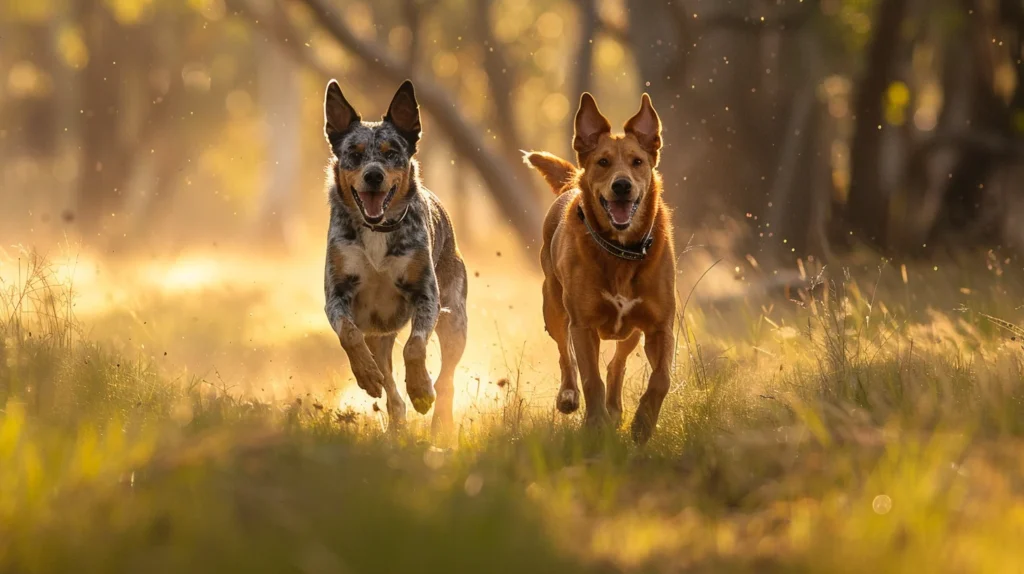
Queensland Heelers and Australian Cattle Dogs are extremely energetic breeds requiring regular exercise. They are bred to herd cattle over long distances, meaning they thrive on physical and mental stimulation.
Exercise Requirements
Both breeds are highly active and need at least 1-2 hours of exercise daily. Keeping them physically engaged is key, whether it’s a brisk walk, a game of fetch, or even agility training. They may become bored and destructive without proper activity, which can lead to behavioural issues.
Mental Stimulation
In addition to physical exercise, these dogs need mental challenges. A Queensland Heeler or Australian Cattle Dog excels in activities like puzzle toys, training sessions, and problem-solving games. These activities provide the mental stimulation they crave and prevent them from becoming restless.
Best Activities for Both Breeds
Active outdoor activities are a must for these breeds. Both dogs excel in activities like running, hiking, or even swimming. On average, Australian Cattle Dogs and Queensland Heelers are known to be able to run at speeds of up to 30 mph (48 km/h), so they need a lot of space to stretch their legs.
Training for Exercise
Training and exercise go hand in hand for these breeds. Incorporating obedience training into their daily routine ensures they are well-behaved during exercise. This combination of physical and mental work is key to maintaining their health and happiness.
Grooming and Care
Queensland heelers and Australian cattle dogs have similar grooming and care needs, though there are slight differences. Regular grooming is essential to keeping their coats healthy, and paying attention to their diet and health will ensure they stay in top shape.
Grooming Needs
Both breeds have short, dense double coats that shed seasonally, requiring regular brushing. I recommend brushing them at least once a week to remove loose fur and prevent matting. During shedding seasons, you may need to brush more frequently, up to 2-3 times a week. Regular grooming will also help reduce the amount of fur around the house.
Bathing Routine
Bathing isn’t needed as frequently, usually every 4-6 weeks, unless they get dirty. I’ve found that over-bathing can strip their natural oils, so using a gentle, dog-friendly shampoo is essential. A quick rinse after a muddy play session can help maintain their cleanliness without overdoing it.
Diet and Nutrition
Both breeds are highly active, so their diet should reflect that. Aim for high-quality dog food with a minimum of 20-30% protein for a healthy, balanced diet. For instance, a 25kg (55lb) Australian Cattle Dog may require around 1.5 to 2 cups of food daily, depending on its activity level. Avoid fillers like corn or soy, which don’t provide much nutritional value.
Dental Care and Health Maintenance
Dental hygiene is often overlooked but is crucial for both breeds. Regular tooth brushing, ideally 2-3 times a week, helps prevent gum disease and bad breath. You should also schedule annual vet checkups and watch for early signs of health issues, such as limping or changes in appetite, which could indicate joint or dental problems. In our article, Differences between Australian Cattle Dog and Australian Shepherd, we explore the differences between the two breeds.
Choosing the Right Dog for You
When deciding between a Queensland Heeler and an Australian Cattle Dog, you’ll want to consider your lifestyle, living space, and how much time you can dedicate to exercise and training. Let’s break down these factors to help you make the best choice!
Lifestyle Compatibility
If you’re an active person who loves outdoor activities, both breeds will thrive in your environment. The Australian Cattle Dog, for example, needs at least 1 hour of exercise daily to stay happy and healthy. On the other hand, Queensland Heelers can manage with about 45 minutes, but they’ll still want to keep moving!
Living Space Considerations
These breeds are best suited for homes with plenty of room to roam. If you live in an apartment, consider that both dogs might feel cramped without access to a yard. Ideally, you’d need a larger backyard or access to open spaces, as both breeds have a strong herding instinct and love to move around.
Adoption vs. Buying
Looking to adopt? Both Queensland Heelers and Australian Cattle Dogs are available at rescue shelters, and it’s a great way to provide a loving home to a dog in need. Prices for purchasing a well-bred dog typically range from $500 to $1,500, depending on the breeder and the dog’s lineage. Adoption costs are usually lower, but you might have to wait for the right match.
Final Words
When comparing the Queensland Heeler and Australian Cattle Dog , both breeds stand out with their high energy and herding instincts. If you’re looking for a loyal companion, both dogs will give you 12-15 years of dedicated companionship.
While both require a lot of exercise, the Queensland Heeler’s shorter tail and slightly more reserved nature make it unique. Whether you choose one, both will keep you on your toes with their intelligence and need for mental stimulation!
Explore the American Kennel Club’s comprehensive profile on the Australian Cattle Dog.

